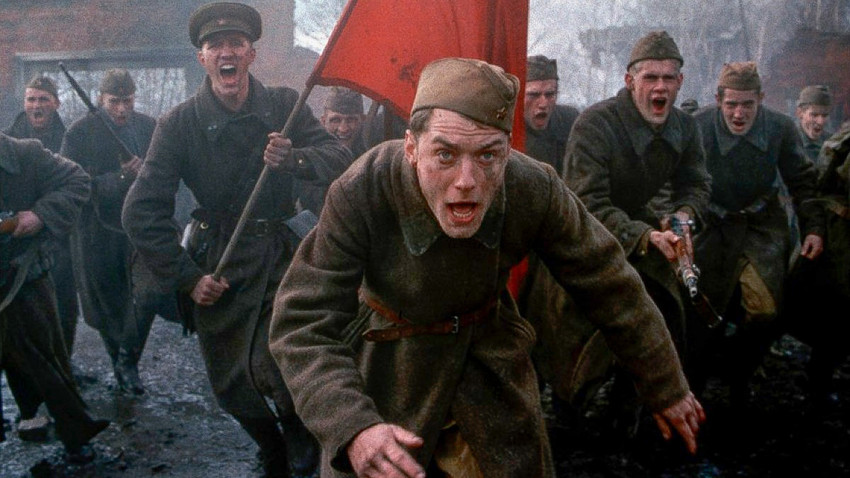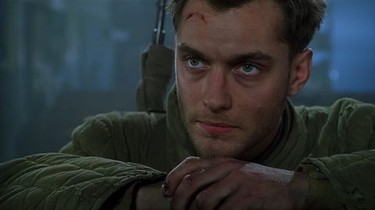ENEMY AT THE GATES

Enemy at the Gates (2001): A Tale of War, Survival, and Ideological Conflict
Introduction
Enemy at the Gates, directed by Jean-Jacques Annaud and released in 2001, is a war drama set during the Battle of Stalingrad in World War II. The film, based on the true story of the sniper duel between Soviet marksman Vasily Zaitsev and German sniper Major Erwin König, combines the intensity of war with personal struggles and ideological conflict. Starring Jude Law as Zaitsev, Ed Harris as König, and Rachel Weisz as Tania Chernova, the film offers a gripping and personal look at one of the bloodiest battles in history.
Plot Summary
The story unfolds in the winter of 1942 during the brutal Battle of Stalingrad, one of the most pivotal confrontations of WWII. The German army is attempting to capture the city, which is a vital industrial and strategic target for the Soviet Union. Amid the chaos and devastation of the battle, Vasily Zaitsev (Jude Law), a Soviet soldier and skilled marksman, becomes a hero for the Red Army. His precision shooting and ability to kill German soldiers from great distances make him a symbol of hope for the Soviet troops who are fighting against overwhelming odds.
Zaitsev’s fame grows quickly, but it also attracts the attention of the German military. In response, the Germans send their best sniper, Major Erwin König (Ed Harris), to eliminate Zaitsev and demoralize the Soviet forces. A tense and deadly cat-and-mouse game ensues between the two snipers, each trying to outwit and outshoot the other in the ruins of Stalingrad. Alongside this sniper rivalry, Zaitsev forms a bond with Tania (Rachel Weisz), a Soviet soldier and his love interest, whose role in the war also brings both romance and tragedy to the story.
As the battle rages on, Zaitsev’s role grows more crucial, and he must grapple not only with his responsibility as a sniper but also with the horrors of war and the pressure of leading the resistance against an implacable enemy.
Themes and Character Dynamics
Enemy at the Gates explores themes of survival, heroism, and the psychological toll of war. The film delves deeply into the mindset of a soldier, particularly one involved in the brutality of sniper warfare, which requires immense patience, focus, and a certain detachment from the human cost of killing. Zaitsev is presented as a reluctant hero, thrust into the spotlight due to his extraordinary abilities, but he struggles with the personal cost of his fame and the moral dilemmas that come with taking lives from such a distance.
The rivalry between Zaitsev and König serves as the film’s central focus, and it is framed as a clash of ideologies. Zaitsev, a humble Soviet soldier fighting for his country, represents the hope of the common man, while König, a cold, professional soldier of the Nazi regime, embodies the discipline and ruthlessness of the enemy. Their contest is more than just a duel of marksmanship; it’s symbolic of the broader ideological conflict between fascism and communism, survival and sacrifice.
Tania’s character provides an emotional anchor in the midst of the chaos. She serves as both a love interest and a symbol of the resilience of the Soviet people, but her relationship with Zaitsev also underscores the personal costs of war. Their romance, though touching, is set against the backdrop of destruction and loss, and it highlights the fleeting nature of love in times of war.
Jude Law and Ed Harris’s Performances
Jude Law delivers a compelling performance as Vasily Zaitsev, capturing the internal conflict and quiet determination of a soldier who becomes a reluctant hero. Zaitsev is not a typical action hero, and Law’s portrayal emphasizes the character’s vulnerability and humanity. The film showcases Zaitsev’s emotional turmoil as he faces the moral complexities of killing in war, which adds depth to his role as a sniper.
Ed Harris’s portrayal of Major König is equally strong. He plays the German sniper with a cold, calculating demeanor, exuding a sense of professionalism and duty to the Nazi cause. König is a man of principle, bound by honor and a sense of superiority. Harris’s performance gives the character a quiet intensity, and his character’s dedication to his mission creates an eerie, almost tragic counterpoint to Zaitsev’s more conflicted nature.
Rachel Weisz also shines as Tania, adding emotional depth to the film. Her character’s devotion to Zaitsev and her sense of duty are portrayed with grace and subtlety. Tania represents the strength of the Soviet women who fought in the war and highlights the emotional and physical sacrifices made by all soldiers, regardless of gender.
Direction and Cinematography
Jean-Jacques Annaud’s direction brings a gritty realism to the film, with intense battle sequences and moments of quiet tension between the snipers. The film captures the harshness of war, not only through its violent action but also through its portrayal of the psychological toll on soldiers. Annaud uses the desolate landscape of Stalingrad to emphasize the hopelessness and devastation of the battlefield, with the ruins of the city serving as a stark visual metaphor for the destruction of both physical space and human lives.
The cinematography by Robert Fraisse uses muted tones and shadows to create a sense of despair and moral ambiguity. The stark, cold visuals of the battlefield contrast with the warmth of the relationships between the characters, particularly Zaitsev and Tania. The camera work is tense, especially during the sniper duels, with the use of long shots and close-ups adding to the suspense and drawing the audience into the perspective of the snipers as they silently track their targets.
The battle scenes, while dramatic, do not glorify the violence of war. Instead, they highlight the brutality and chaos that soldiers must endure. The film does not shy away from showing the harsh realities of war, including the emotional and physical toll it takes on those involved.
Historical Accuracy and Legacy
While Enemy at the Gates is based on real events, some aspects of the film are fictionalized for dramatic effect. The rivalry between Zaitsev and König is historically accurate, but many of the personal interactions and romantic subplots, particularly Zaitsev’s relationship with Tania, are fictionalized. The film takes some liberties with the timeline and characters to create a more engaging narrative.
Despite these liberties, Enemy at the Gates succeeds in portraying the grim reality of the Battle of Stalingrad and the key role snipers played in the conflict. The film shines a light on the bravery and ingenuity of Soviet soldiers, particularly the Code Talkers who helped to turn the tide of the battle. The film also raises awareness of the human cost of war, not only for the soldiers involved but for the families and civilians who bear the consequences of such conflicts.
The film’s reception was mixed. While it received praise for its performances, particularly from Law and Harris, some critics noted that the film could have delved deeper into the historical context and the psychological effects of war. The action sequences, though intense, sometimes overshadow the emotional complexity of the story.
Conclusion
Enemy at the Gates is a powerful and thought-provoking war film that explores themes of survival, heroism, and the psychological toll of battle. The sniper duel between Vasily Zaitsev and Major Erwin König is the film’s central focus, but the emotional stakes of the characters’ relationships and their internal struggles give the film depth. Jude Law and Ed Harris deliver memorable performances that bring the complex characters to life, and Jean-Jacques Annaud’s direction creates a tense, immersive experience. Though the film takes some dramatic liberties, it succeeds in portraying the brutal reality of the Battle of Stalingrad and the heroic efforts of those who fought there. Enemy at the Gates is a war film that is as much about the human experience as it is about the violence of war, making it an unforgettable exploration of conflict, courage, and sacrifice.











